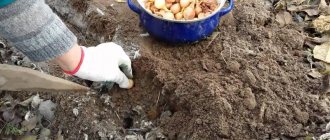A wetland is a big problem for summer residents and owners of country houses. Trying to get rid of it by filling the area with sand or other soil is useless. This hydraulic system is quite resistant to external influences. Therefore, if you are looking for an answer to the question of how to drain a swampy area
, then you should immediately exclude this method. But there are ways to combat the swamp, and they are quite effective. The most accessible reclamation and drainage measures that can be carried out by a private owner without the involvement of specialists will be discussed below.
Features of wetlands
Before you begin draining a wetland
, it is necessary to determine the type of swamp. It can be lowland or upland.
In the first case, the swamp is located in the natural lowland of the site and excessive moisture here is a consequence of the close location of groundwater. As a rule, the soil in such an area is fertile, but perennial plants do not take root well and disappear after a few years.
Raised bogs can appear even on the top of a hill. The reason for this is the inability of the soil to pass through itself moisture coming with precipitation. Most often, such areas are represented by clay soil, which does not allow water to seep to the lower soil layers.
Drainage
The most effective methods of draining a swamp that appears in a dacha include making a drainage system. In this case, drainage of the wetland
is a network of perforated pipes laid in ditches up to 1 meter deep. Drains are dug with a slope so that water flows through them into a special drainage well or natural reservoir located below. It is recommended to make such drainage in the shape of a herringbone, where the water will be collected in small-diameter pipes and drained through them into a large diameter or general drainage ditch. If the final place for collecting water is a well, then it is dug to a depth of 0.5-1.0 meters below the groundwater table. The bottom of the well is covered with a layer of crushed stone.
Pipes and wells
So, it turns out that you need drainage. This means it’s time to start excavation work before the autumn dampness makes it too difficult.
Proper drainage consists of three parts. Depending on the area of the site and the amount of water on it, you can build a drainage system completely or abandon some of its components.
Pipes around the perimeter of the site. Perforated pipes are laid in the ditch to a depth of 80 cm on crushed stone, then the trench is filled with crushed stone, and on top with soil. But such drainage is not enough for a large area, and there is a possibility of “siltation”.
Pipes on site. To lay them, you will need to dig an extensive system of trenches. The central pipe is directed from the highest point of the site to the lowest - it is through this pipe that water will flow from the site. Branch pipes are connected to the central pipe. These pipes will collect water from the far ends of the site and carry it into the main pipe. The central pipe with a diameter of 200–250 mm is buried in the ground to a depth of 80 cm. The remaining pipes with a diameter of 60–80 mm are laid at a depth of 30–40 cm with a slope towards the main pipe. Branch pipes are laid every 8 m at an angle of 60 degrees to the central pipe.
Drainage wells. It is into them that water collected in drainage pipes will flow if your village does not have a general drainage system. The well is a hole with a volume of one and a half cubic meters. The pit is lined with geotextile and filled with crushed stone, broken brick, broken tiles and plaster, and topped with a 30 cm thick layer of soil. Wells are installed in the lowest place, their number depends on the area of the site.
Large trees protect the garden from waterlogging. Photo: From personal archive/ Nina Drobysheva
Tree planting
It has long been known that trees can save the earth from waterlogging. They absorb large amounts of water with their roots, evaporating it through their leaves into the atmosphere. The most useful species in this regard include poplar, birch and willow. Of course, trees will not grow in one year. Therefore, if the first signs of waterlogging are observed in the area, you need to take care of planting. Moisture-loving crops that require abundant watering will help speed up the drainage process. But if the soil is very moist, it is easier to grow them, and the benefits for the site will be greater.
Raised beds
To be able to grow vegetables and herbs in a wetland, it is not necessary to deal with the drainage of the area. You can simply make high beds, the water from which naturally flows into the rows, ridding the cultural layer of soil of excess moisture. The higher the bed, the more varieties of cultivated plants can be grown on it. In Finland and Holland, it is high beds that save local farmers from high groundwater levels and allow them to get very good harvests.
The easiest way to have a beautiful front lawn
You've certainly seen the perfect lawn in a movie, on an alley, or perhaps on your neighbor's lawn. Those who have ever tried to grow a green area on their site will no doubt say that it is a huge amount of work. The lawn requires careful planting, care, fertilization, and watering. However, only inexperienced gardeners think this way; professionals have long known about the innovative product - liquid lawn AquaGrazz .
Plants disappear because the wet soil does not allow enough oxygen to pass through, and the roots suffocate, and groundwater contributes to their rotting. Also, toxic products (aluminum salt, nitrates, various types of gases, acids) are often formed in wet, swampy soil, which interfere with plant growth.
Methods for draining lowland swamps
Drainage of low-lying swamps is possible using the following methods:
Help from professionals
You can invite a team of specialists who, using pumps, will almost instantly pump out all the excess water from the area; significant drainage can be observed on the same day. But this is quite expensive, and sometimes the problem of waterlogging returns.
Sanding
Adding sand in equal proportions to the parent rock improves the quality of the soil, and also increases air exchange. In order to improve the yield of the resulting soil, it is recommended to add humus to it, which will allow you to grow vegetables and herbs on the site.
Drainage
To effectively and permanently drain a swampy area, all experts recommend making a drain or drainage. It is best done using a system of plastic pipes with small holes in the walls. They should be laid in specially dug ditches with a depth of about 60-70 cm for clay, 75-85 for loam and up to a meter for sandy areas. Drains must be dug with a slope, so the water will not stagnate in them, but can flow into a sewer pipe, well or reservoir; this should be the lowest point of the site.
Trees in a swampy area
It is most effective to use a herringbone system, in which small pipes collect excess moisture from around the area and carry it to the main pipe, which carries the water out of the area. In swampy gardens, as a rule, there is already a common drainage ditch; if it is missing, the water can be diverted to the nearest body of water. You can also dig a well, the lower boundary of which will be below the groundwater level, fill it with crushed stone, and water will flow into it. With such an integrated approach, the drying of the area will be noticeable within a couple of days to a week. The drains themselves can be covered with earth, but to make maintaining them easier, you can fill them with gravel or crushed stone.
Open ditches
To remove excess moisture directly from the surface of the earth, you can make open ditches, the edges of which should be beveled by about 20 degrees to avoid shedding, but this method is not used in sandy areas, since the ditches quickly collapse and the sand is washed away. This method of drainage is very common; it can be seen in almost every garden. The disadvantage of this method is the gradual crumbling, clogging of the watercourse with plant particles and debris, and water blooming, so these structures must be regularly cleaned with a regular shovel.
French ditches
In France, drainage of wetlands is carried out using deep ditches filled with crushed stone. For the system to be effective, you need to either dig trenches and lead them into the well, or dig ditches down to a layer of sand that will allow water to pass through. Such ditches are more aesthetically pleasing, do not clog and do not bloom, but if they are clogged with earth, cleaning becomes very difficult. But the ditch can be disguised as a path by strewing it with pebbles, crushed stone or laying wooden slices on top.
Wells
The technology of their operation is similar to ditches; for this it is necessary to dig holes one meter deep, about half a meter in diameter at the bottom and up to two at the top. They should be dug at the lowest points of the site, and then covered with crushed stone. All excess water will flow into such wells.
Dig a pond
After the construction of a decorative pond, excess water will flow into it and evaporate, and soon a significant drainage of the area will be observed. For these purposes, the Cross Canal was built a long time ago in the French residence of the monarchs at Versailles - the effectiveness of the method is obvious.
Drainage of swampy areas
Tree planting
Some tree species can save a wetland from waterlogging. The most useful for these purposes are willows and birches, which can evaporate large amounts of moisture through the leaf blades. These trees effectively dry out nearby areas of soil, although it may take several years to completely dry the area. You can think through the design of the site in advance, initially planting only moisture-loving crops, and when the trees have completed their task, move on to the desired types of plants.
Raised beds
To be able to grow vegetables and herbs, owners of wetlands must build raised beds, so that excess moisture will collect in the ditches between the beds, and the areas themselves will become noticeably drier. Moreover, there is such a pattern: the higher the plot is raised, the more diverse crops can be grown on it. Many people think that it is impossible to farm in waterlogged areas, but you just need to look at photographs of a Dutch or Finnish vegetable garden surrounded by a complex system of canals to be convinced of the effectiveness of the method. After all, in these countries, with the help of technology and labor, almost everything is grown, and they also make good money from it.
Imported soil
The level of the site can be raised with the help of additionally imported land, which, after plowing, will be mixed with fertile but heavy marshy soils, as a result the site will become suitable for growing crops and very fertile; experts note that cultivated marshy lands do not require fertilization for several more years.
Imported soil
If the cause of waterlogging is heavy soil, then adding fertile soil to it can improve the condition of the site. The water will go deeper, leaving the top layer of soil suitable for growing garden crops. As practice shows, swampy soils retain their fertility for a long time and do not require additional fertilizers for several years.
If you don’t plan to actively cultivate garden crops on your personal plot, then you can come to terms with the swampiness of the area; it’s enough to improve it. In waterlogged soil you can grow rhododendron, thuja, lingonberries, hydrangea and many other beautiful and useful plants. Thus, you can turn the site into a beautiful corner for rest and relaxation.
How to drain a swampy area on an elevated area
In areas of the watershed of the territory, a raised bog may form. It is completely independent of the groundwater level, but is formed in an area composed of clay soils. Clay does not allow water to pass through; it accumulates in the top layer of soil.
To drain the raised swamp, you will need to make a system of drainage ditches or trenches. You can do without them if you raise the area, bringing in light soil, sand, humus, and mixing them with the top layer of soil.
As a rule, the fertile layer of raised bogs has an acidic environment. Plants will not grow well on such soil. Therefore, it is recommended to reduce acidity by adding chalk or slaked lime to the soil.
There are many ways to combat wetlands. There are quite simple ones, and there are also complex and expensive ones. It is necessary to drain the area only after studying its features. It is important to remember that by draining a garden or backyard area, you can contribute to waterlogging of neighboring areas. Therefore, before doing anything, it is necessary to consult with specialists and notify the owners of neighboring farms or houses. And if possible, order a drainage project from a specialized company, which will eliminate various unpleasant nuances that may arise when making drainage yourself.
Cottage in a swamp: disadvantages of a garden in a lowland
Naturally, a garden in a lowland does not cause much delight among gardeners, since it has quite a few disadvantages:
- firstly, the air stagnates in the lowlands, which means that for a site located in a swamp there are much fewer suitable fruit trees than for a plain or on a slope. Therefore, the choice of fruit and berry crops, as well as other plants, for the lowlands is limited. When purchasing them, pay attention not only to their frost resistance, but also to their winter hardiness (frost resistance is the ability to withstand frost, and winter hardiness is the ability to withstand winter thaws);
- secondly, in the lowlands spring frosts are 3–5 degrees lower than on the plain. Therefore, when the weather forecast promises soil frosts of 2–3 degrees, then in your area it will be 5–8 degrees;
- thirdly, in the spring, in the lowlands, when the snow melts, water accumulates and stagnates, which leads to the soaking of the root system of crops growing there.
However, this does not mean at all that nothing can be grown in a low-lying area without large expenses for reclamation and soil filling. A special case is if your dacha is located in a swamp and water meadow along a floodplain, as well as next to a pond, ditches and in a ravine.
In the lowlands, you cannot plant fruit trees and berry bushes in holes, just like on the plain in places where the groundwater is high. The roots of the plant in the lowland will end up in water, and gradually it will die. You can’t plant plants on clay either, but for a different reason. Clay, swelling during autumn rains, does not allow moisture to pass through. Therefore, the soil in the hole freezes through, which causes the death of the root system. What should you do if the site is in a lowland, and what should you plant on swampy soil to make the plants in the lowland comfortable?











